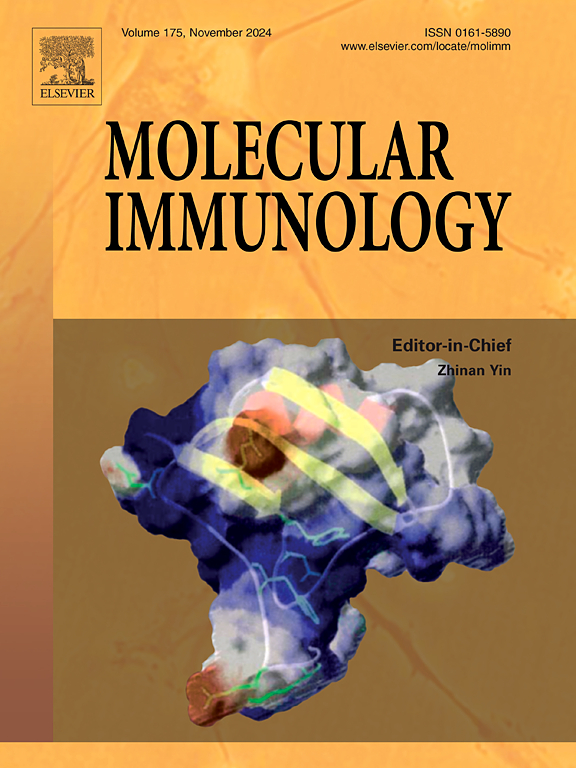肺变态反应模型中,低收缩气道平滑肌表型β2层粘连蛋白链表达增强
IF 3
3区 医学
Q2 BIOCHEMISTRY & MOLECULAR BIOLOGY
引用次数: 0
摘要
用卵清蛋白(OVA)致敏豚鼠诱导抗OVA IgE产生各种过敏反应表型。一种表型,其特征是对慢性抗原攻击没有支气管阻塞和气道高反应性,被称为无反应(NR),并表现出高IFN-γ水平。Th1细胞因子谱与层粘连蛋白β2的高表达有关。本研究评估了层粘连蛋白β2在慢性NR表型中的表达。用OVA致敏和攻毒豚鼠3次(急性)或12次(慢性)。对所有挑战都有反应的豚鼠形成了哮喘模型表型。对照组致敏并给予生理盐水刺激。采用免疫组化方法观察层粘连蛋白β2及其受体α6整合素亚基在支气管和动脉肺内平滑肌中的表达。只有慢性NR豚鼠在这些肌肉中表现出层粘连蛋白β2的表达增加,而在其他组中保持相似。α6整合素亚基在急、慢性哮喘模型、慢性对照和NR豚鼠支气管平滑肌中显著升高。急性NR和慢性哮喘模型豚鼠动脉肺内平滑肌α6整合素亚基升高。层粘连蛋白β2在支气管和动脉肺内平滑肌中的表达与α6整合素亚基水平相关,较高的层粘连蛋白β2水平与减少抗原诱导的支气管阻塞和组胺反应性显著相关。这些蛋白的表达不影响肺血管的增殖。层粘连蛋白β2链过表达可能参与了阻塞性过敏反应的慢性抑制。本文章由计算机程序翻译,如有差异,请以英文原文为准。
Hypocontractile airway smooth muscle phenotype exhibits enhanced β2 laminin chain expression in lung allergy model
Sensitization with ovalbumin (OVA) in guinea pigs to induce anti-OVA IgE generates various allergic response phenotypes. One phenotype, characterized by the absence of bronchial obstruction and airway hyperresponsiveness in response to chronic antigen challenge, is termed non-responding (NR) and exhibits high IFN-γ levels. The Th1 cytokine profile is linked with high laminin β2 expression. This study evaluated laminin β2 expression in the chronic NR phenotype. Guinea pigs were sensitized and challenged with OVA three times (acute) or twelve times (chronic). Guinea pigs that responded to all challenges formed the asthma model phenotype. Controls were sensitized and challenged with saline. Immunohistochemistry was used to observe laminin β2 and its receptor, the α6 integrin subunit, in bronchial and arterial intrapulmonary smooth muscles. Only chronic NR guinea pigs showed increased laminin β2 expression in these muscles, while it remained similar in other groups. The α6 integrin subunit significantly increased in the acute and chronic asthma models, chronic controls, and NR guinea pigs in bronchial smooth muscle. In arterial intrapulmonary smooth muscle, the α6 integrin subunit increased in acute NR and chronic asthma model guinea pigs. The expression of laminin β2 in bronchial and arterial intrapulmonary smooth muscles correlates with α6 integrin subunit levels, and higher levels of laminin β2 were significantly related to reduced antigen-induced bronchial obstruction and reactivity to histamine. The expression of these proteins does not affect the proliferation of pulmonary blood vessels. Laminin β2 chain overexpression is likely involved in the chronic containment of the obstructive allergic response.
求助全文
通过发布文献求助,成功后即可免费获取论文全文。
去求助
来源期刊

Molecular immunology
医学-免疫学
CiteScore
6.90
自引率
2.80%
发文量
324
审稿时长
50 days
期刊介绍:
Molecular Immunology publishes original articles, reviews and commentaries on all areas of immunology, with a particular focus on description of cellular, biochemical or genetic mechanisms underlying immunological phenomena. Studies on all model organisms, from invertebrates to humans, are suitable. Examples include, but are not restricted to:
Infection, autoimmunity, transplantation, immunodeficiencies, inflammation and tumor immunology
Mechanisms of induction, regulation and termination of innate and adaptive immunity
Intercellular communication, cooperation and regulation
Intracellular mechanisms of immunity (endocytosis, protein trafficking, pathogen recognition, antigen presentation, etc)
Mechanisms of action of the cells and molecules of the immune system
Structural analysis
Development of the immune system
Comparative immunology and evolution of the immune system
"Omics" studies and bioinformatics
Vaccines, biotechnology and therapeutic manipulation of the immune system (therapeutic antibodies, cytokines, cellular therapies, etc)
Technical developments.
 求助内容:
求助内容: 应助结果提醒方式:
应助结果提醒方式:


